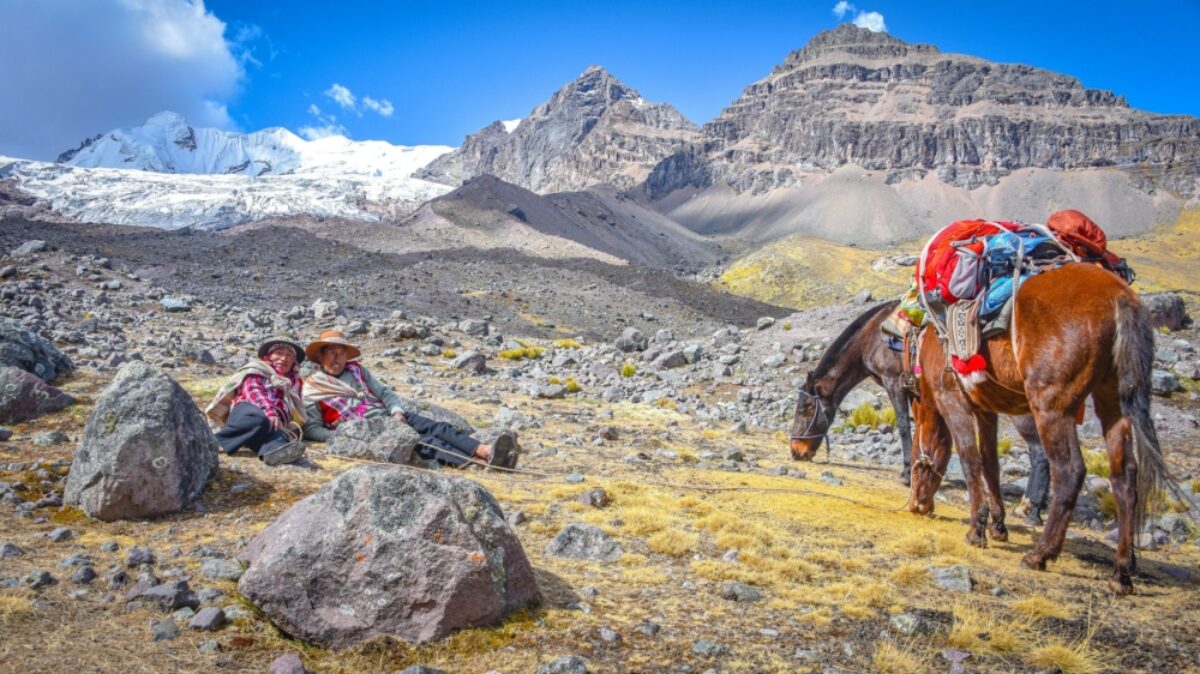Hiking the Ausangate trek
The rugged, wild and challenging trek
Because Ausangate Mountain is in the opposite direction to Machu Picchu, this trek is not typically described as an alternative to the Inca Trail. This can be to your benefit, however, as it also gives you the opportunity to explore the Andes on a trail that is far less travelled.
The classic Ausangate route is a beast of a trek, although – as with Salkantay – there is a lodge version that brings some very welcome creature comforts to the overall experience.
The Ausangate Trek
Difficulty: Challenging
Distance: Approx. 96km (60m)
Duration: Four to five days
Max elevation: 5,200 metres
Accommodation: Camping
Start/end point: Tinki - Pacchanta

Horsemen in traditional Quechua dress following the Ausungate trail
What you’ll see
The landscape here is rugged, wild, and pristine. You’ll be surrounded by awe-inspiring glacier mountains, turquoise lagoons of various sizes, and wildlife such as an abundance of waterfowl, raptors, and vizcachas, a cousin of the chinchilla. There are also some high mountain communities in this area who shepherd their alpacas in the region and offer some of the most beautiful weavings you’ll see in Peru. You’ll also get to soothe your aching feet in hot springs along the way.
The colourful mountain
As a climax of this route, trekkers arrive on the fourth day to a sight they’ve seen in all the photos: the “colourful mountain”. This ridge has also been nicknamed the “painted mountain” and the “rainbow mountain” by those trying to express the surreal layers of pastel purples, greens, yellows and reds that stripe it. Describe the scene how you will, and have your cameras ready, but you really do have to see it to believe it!
How long is the Ausangate trek?
The traditional Ausangate trek spans five days and takes you over about 60 miles or so of terrain and up to a maximum altitude of around 5,200m (16,000 ft) above sea level. The lodge-to-lodge hikes are offered in variations from just two days up to seven, so you can find a route that meets your interest and fitness level.
How difficult is the Ausangate trek?
The classic Ausangate trek is extremely challenging, in particular, because of the altitude, not to mention the cold nights. The lodge routes (see below) are a very different experience, although the extra comforts won’t negate the altitude, weather and gruelling ascents.
Accommodation
On the classic camping trek, which loops around Mt. Ausangate, you’ll be camping for four nights in marked campsites that are more or less maintained by local communities.
The lodge route takes you from lodge-to-lodge, each one as beautiful as the last and all constructed from local materials. Part-owned and operated by members of the nearby Chillca community, the lodges are a great example of inclusive tourism. Although there is no electricity, the lodges are comfortable and cosy, especially in the evenings around the fire. The fresh meals prepared each day are delicious and you can even have a hot shower!
How to book
This is another trek that needs no permit and can, theoretically, be done solo. Yet it is highly advisable to book with a local trekking operator. With the higher altitude and more remote conditions, you will need a guide and support staff who are well-versed in the requirements of trekking in this area.
Key considerations
Even the very fit will find this a challenging route due to the altitude. An emergency horse will be available for exhausted trekkers but should not be relied upon for completing the trek. Make sure you’re fit, healthy, fully acclimatised and not suffering from any stomach troubles before you set off.
Local communities graze alpacas in the area, so there are hundreds of animal trails that can easily be confused with the main trekking trail.
Be prepared for long nights at low temperatures (below freezing at night). If you are tent-camping, layers and proper equipment are vital. Most tours do not include a sleeping bag, but they can be rented. It’s advisable to bring an additional sleeping bag liner for extra warmth.
You’ll be able to purchase weavings in the communities you pass through--it’s much welcome support for a traditional (and waning) livelihood. Bring small change if you’d like to stock up on souvenirs. Buying directly from the women who raise the alpaca, shear the wool, spin the yarn and weave the final product is even better than “fair trade.”




